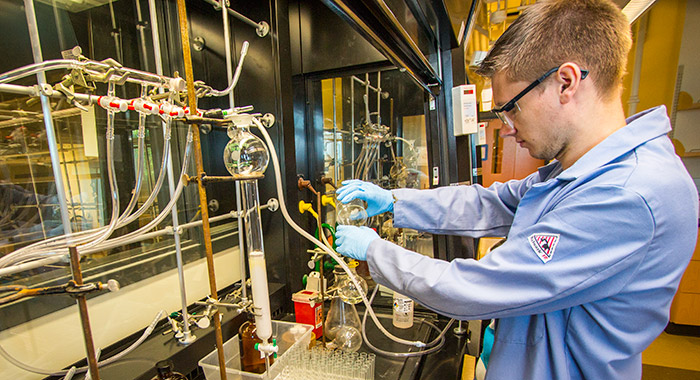New Facilities Heat Up Summer Research Opportunities
The transformational environment that will be the new Gehl-Mulva Science Center (GMS) is not set to open fully till July 2015 – but this summer’s faculty-student research teams are enjoying the many customized lab environments already in use.
For developing scientists, summer research opportunities both at St. Norbert and at other institutions are highly sought-after experiences. “As former undergraduate researchers ourselves, we valued the experience when we were undergraduates,” says Kurstan Cunningham (Chemistry). “So we want to create that experience here for our students.”
A future taking flight
Elizabeth Paitel ’16 and Jordan Gunderson ’16 have been working beside David Bailey (Biology) in one of the science center’s innovative new labs, each customized to allow cutting-edge research across a host of scientific disciplines and interests.
Under the guidance of Bailey – who has spent years studying animal physiology, neurology and behavior – Paitel and Gunderson are using the zebra finch as a model organism to study the role that the hormone estrogen plays in learning and memory. They are manipulating estrogen production and activity while conducting a series of tests of spatial memory function, specifically the ability of the birds to learn and remember the location of a food source.
Both Paitel and Gunderson embarked on their summer research as McNair scholars. The McNair program encourages and sponsors often-underrepresented students into graduate programs and even doctoral degrees. Paitel and Gunderson’s cross-discipline psychology and biology research will serve as a stepping-stone toward their pursuit of a post-graduate education.
Unprecedented findings
“It’s a science-fair project gone crazy,” is how Andrew Baert ’16 describes his research in chemical ecology. Working alongside David Poister (Chemistry, Environmental Science) – whose own research interests flow from biogeochemistry and aquatic systems – the pair is focusing their microscopes on two interacting species of algae found in the Fox River.
“One species of algae is a green algae, which is what you traditionally think of when you think ‘algae.’ It floats in the river, and it is what makes the river appear super-greenish. The second species of algae is a diatom, which is a type of algae that sort of looks like spaghetti strands under the microscope.”
In the first documented study of its kind, Baert and Poister have discovered the green algae is releasing an allelochemical (chemical signal) that brings the diatom out of its dormant phase, “which it forms to survive the winter,” and into its active one, “where it grows and divides.” It’s the first case where green algae allelochemicals affect the receiving diatom while it’s dormant and, what’s more, have been seen to positively alter the diatom instead of hurting it.
Baert, a chemistry major and physics minor with a secondary education certificate, cites the benefits of working in a lab designed specifically for doing environmental chemistry. He believes that specialized equipment, such as growth chambers and laminar flow instruments, heighten the ability to study allelopathic rejuvenation.
The pair’s next step? Determining the structural characterization of this allelochemical, the results of which could generate activity studies into its molecular structure.
Laboratory sample
Among other research projects in GMS this summer:
- Katelin Selner ’16 and Amber Kelley ’15 are working with Kathleen Garber (Chemistry) to study organisms called endophytes – bacteria or fungi living inside plants. These organisms produce compounds that may benefit the host plants and can be isolated for possible antimicrobial activity, with potential for use in antibiotics.
- David Yanda ’16 is working with Anindo Choudhury (Biology, Environmental Science), using morphological and molecular techniques to discriminate between species of a particular group of parasites from the United States and Canada. So far, they have identified what appear to be three species.
-
Reed Colling ’15 is also working with Choudhury, using molecular techniques (DNA amplification and sequences) to uncover cryptic species of tapeworms. (Cryptic species are those that appear to be the same but are actually different). Colling holds this year's Anselm Keefe Biology summer fellowship.
- University of Wisconsin-Green Bay senior Richard Sanderson is also working with Choudhury, analyzing rainbow trout diet and feeding habits in the Grand Canyon.
- Cole Brennan ’16 is working with Carrie Kissmann (Biology) to reduce algae blooms and increase water clarity in a pond near Austin Straubel International Airport.
- Olivia Koehn ’16, Joe Lovas and Hannah Johnshoy ’17, with Zachary Pratt (Biology) are working to elucidate the role of outer membrane proteins (Omps) in the growth and survival of Escherichia coli to stress. Since certain equipment needed to analyze results and perform specific procedures is housed in GMS, the pair generally makes a trip or two to the new building each day from their current temporary base in the Pennings Activity Center.
- Colton Wiesner ’16 is working with Pratt to isolate bacteriophage (a virus that infects a bacterium) from the Fox River that infect Flavobacterium columnarae, a bacterium that causes columnaris disease in fish. The pair are hoping to characterize the bacteriophage they isolate with the goal of treating infected fish in aquaculture.
- Jon Powers ’14, Jack Roets ’16 and Connor Gullstrand ’17 are working with David Hunnicutt (Biology) on a project using genetic knockouts of the same fish pathogen, Flavobacterium columnarae, to identify genes required for disease production in fish. The results will hopefully aid in the development of a vaccine for this infection common in aquaculture. (Powers’ work is supported by Wisconsin Sea Grant, which also provides the team’s supply money.)
Aug. 5, 2014












